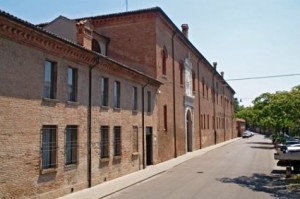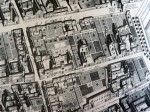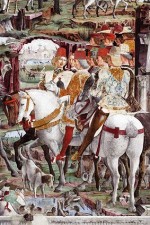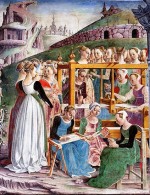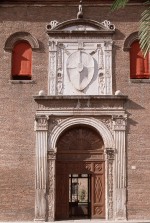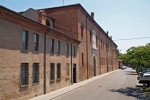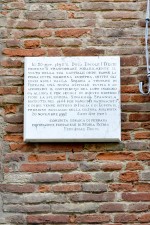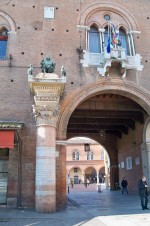Schifanoia Palace
This noble Este residence was built for leisure activities, especially entertaining and hosting guests. That role was generally carried out in the Salone dei Mesi (Hall of the Months), where the iconography of the frescoes directly reference the culture and atmosphere created by Borso d'Este.
The Project
The history of Palazzo Schifanoia begins in the late fourteenth century, when the area was still a large natural expanse near the old route of the Po. It was commissioned by Alberto V d’Este, Marquis of Ferrara. In 1385, he ordered that a square building be designed, a place where he could spend time relaxing (the location and the territorial representation of the building can easily be seen in the 1747 map by Andrea Bolzoni: Plan and Elevation of the City of Ferrara.) This building was originally an Este villa designed for entertaining and leisure. Its very name reveals its purpose, meaning ‘avoiding boredom’, i.e. withdrawing from the daily duties of government to enjoy cultural and recreational activities.
Hall of the Months and Hall of Virtues
Originally just one storey, the building was modified and expanded under the rule of Borso d’Este (Marquis and then Duke of Ferrara from 1450 to 1471). In 1465, Borso commissioned architect Pietro Benvenuti degli Ordini to add an upper floor to the building, designed to hold the ducal apartments, and a reception hall that was decorated by artists from the School of Ferrara, including Francesco del Cossa and Ercole de’ Roberti, with fresco cycle composed of 12 panels distributed around the entire perimeter of the room. Each panel is dedicated to a month, and divided into three parts: on top are triumphant gods, in the middle are zodiac and decanus signs, and along the bottom are the virtues of Borso and good governance. The façade of the building was crowned by a series of painted merlons and colourful geometric designs. An imposing marble portal topped by a unicorn, one of the heraldic symbols of the family, framed the door, along with a large Este coat of arms depicting Borso’s exploits.
After the Renaissance
The building was enlarged one final time by Ercolo I d’Este, the successor to Borso and Duke of Ferrara until 1505. The task was entrusted to Biagio Rossetti, who extended the structure eastwards by seven meters, eliminated the crenellations of the façade, replacing them with a terracotta cornice. When the Este family left Ferrara in 1598, the building was abandoned and fell into disrepair. Being rented out various times, it was gravely damaged: the loggia and the external grand staircase were demolished, while the frescos in the hall were covered by white plaster. The fifteenth-century decorations only returned to light in 1821, thanks to the restoration work of Giuseppe Saroli. On 20 November 1898, the old Este residence was officially re-opened as the Schifanoia Civic Museum.
Due to the earthquake the struck Emilia in 2012, visitors to the building can currently only admire the Hall of the Months and the Hall of Virtues.
Sitography
Fototeca
Related Themes
Related places
Compiling entity
- Musei Civici di Arte Antica di Ferrara
Author
- Elisabetta Capanna

